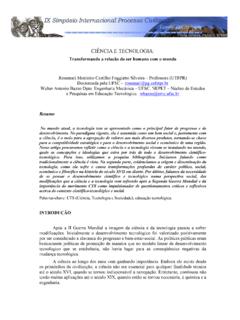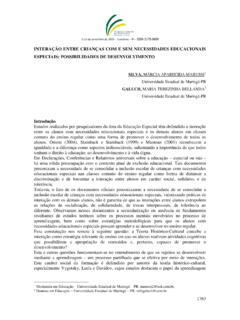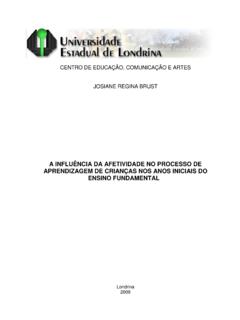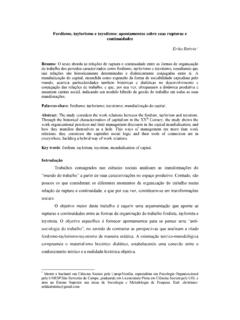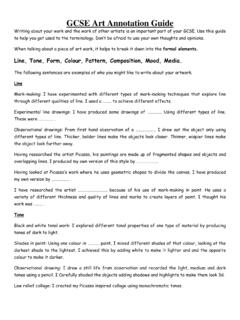Transcription of An Introduction to Functional Grammar - UEL
1 AnIntroductionto FunctionalGrammarTHIRD EDITIONThis page intentionally left blank AnIntroductionto FunctionalGrammarTHIRD HallidayEmeritus Professor of LinguisticsUniversity of Sydney, AustraliaRevised by Christian MatthiessenProfessor of LinguisticsMacquarie University, AustraliaHodder ArnoldA MEMBER OF THE HODDER HEADLINE GROUPF irst published in Great Britain in 2004 byArnold, a member of the Hodder Headline Group,338 Euston Road, London NW1 3 in the United States of America byOxford University Press Madison Avenue, New York, NY10016 2004 Halliday and Christian MatthiessenAll rights reserved. No part of this publication may be reproduced ortransmitted in any form or by any means, electronically or mechanically,including photocopying, recording or any information storage or retrievalsystem, without either prior permission in writing from the publisher or alicence permitting restricted copying. In the United Kingdom such licencesare issued by the Copyright Licensing Agency: Saffron House, 6 10 Kirby Street,London EC1N advice and information in this book are believed to be true andaccurate at the date of going to press, but neither the authors nor the publishercan accept any legal responsibility or liability for any errors or Library Cataloguing in Publication DataA catalogue record for this book is available from the British LibraryLibrary of Congress Cataloging-in-Publication DataA catalog record for this book is available from the Library of CongressISBN-10: 0 340 76167 9 ISBN-13: 978 0 340 76167 03 4 5 6 7 8 9 10 Typeset in 10 on Berling by Phoenix Photosetting, Chatham, Kent Printed and bound in IndiaWhat do you think about this book?
2 Or any other Hodder Arnold title?Please send your comments to ixPart I The Clause11 The architecture of and Grammar and Grammar concepts for the study of language location of Grammar in language; the role of the corpus 312 Towards a Functional a grammatical analysis lexico- Grammar cline and the corpus and functions , Actor, Theme lines of meaning in the clause 583 Clause as and Rheme or phrase complexes as Theme; thematic equatives and mood , interpersonal and topical themes information unit; Given + New + New and Theme + Rheme themes in bound, minor and elliptical clauses interpretation of a text 1004 Clause as nature of dialogue mood element elements of mood structure as system; further options and modality of elements of the modal structure as Subject 1585 Clause as experience of change clauses: processes of doing-and-happening clauses: processes of sensing clauses: processes of being and having process types: summary of process types elements and voice: another interpretation illustrations 303 Part II Above, Below and Beyond the Clause3076 Below the clause: groups and and phrases group group group, conjunction group, preposition group phrase classes and group functions 3617 Above the clause: the clause notion of clause complex of relationship between clauses : parataxis and hypotaxis , extending, enhancing: three kinds of expansion , ideas and facts: three kinds of projection complex and tone 4848 Group and phrase of complexing at group or phrase rank : groups and phrases.
3 Nominal group : adverbial group or prepositional phrase : verbal group, expansion (1): general : verbal group, expansion (2): passives : verbal group, expansion (3): causative : verbal group, projection organization: complexes at clause and group or phrase rank, and groups 5219 Around the clause: cohesion and concept of text; logogenetic patterns lexicogrammatical resources of COHESION and substitution cohesion creation of texture 57910 Beyond the clause: metaphorical modes of Lexicogrammar and semantics Semantic domains Modality Interpersonal metaphor: metaphors of mood Ideational metaphors 636 References659 Index667 ContentsviiThis page intentionally left blank prefaceEarly in the new millennium, after the second edition of IFG had been on salefor some five or six years, I was asked by the publishers: would I like toconsider making some further revisions and preparing a third edition?
4 I feltrather daunted by this prospect. I had worked very readily on IFG2, becausethere were features of the original which clearly needed revising, and I hadsome of the material already in hand. But this time, while there was no doubtthat the book could be further updated and improved, I was not sure that Ihad the necessary energy or expertise to undertake an obvious solution was to work in collaboration; and the obvious personto collaborate with was Christian Matthiessen, if he was willing and if he couldfind the time. He was; and he the event, while I contributed a few sections to the revision, the lion sshare of the work was taken on by Christian. The result is some way betweena revision and a new book. More prominence has been given to the systemnetworks which underpin the Grammar ; and there are many more textexamples, because the systemic Functional model has been widely used in theanalysis of discourse.
5 Inevitably, therefore, the book has become rather longerthan it was before. I hope this has not made it excessively recalcitrant tohandle! It is still (as I said of the first edition) a short Introduction , given therichness and complexity of what it is introducing the Grammar of a HallidayThe first chapter has been largely rewritten, beginning with the motif of usinga Grammar to analyse text, and then introducing the fundamental theoreticalconcepts that make up the architecture of a language: axis, stratification,instantiation, metafunction, composition. The notion of constituency(syntagmatic composition), previously used as the way into the Grammar , ishere given less prominence. Chapters 3 and 4 have been tidied up and extended; andChapter 5 has been considerably rewritten, in order to make the very complex aspects oftransitivity more accessible and to provide more support for text analysis.
6 Chapter 7 hasbeen extensively revised, with more material on the relationship between the clausecomplex and the rhetorical-relational organization of text; and what was Chapter 7additional has become Chapter 8, because Chapter 8 in its original form has disappeared,the content being incorporated into the chapters to which it is related (Chapters 1, 3, 4 and7). Chapter 9 is still concerned with cohesion, but it has been expanded to include adiscussion of instantial patterns in general in text and the presentation of the subsystems ofcohesion has been reorganized so that it now starts with conjunction in order to foregroundthe link to clause complexing in the Grammar and rhetorical-relational organization in thediscourse the chapters we have tried, within the space available, to provide a sense ofhow the Grammar makes meaning in written and spoken text, illustrating the distinctivecontributions made by the different options within a given system.
7 This is one step in thedirection of fleshing out the relationship between Grammar and discourse semantics; buttexts inevitably take up a good deal of space, and we have had to remove a number ofexamples we had originally included. These will find their way into other publications, orbe added to a new website that we are designing as a companion to web companion to IFG will enable us to make available certain material from IFG2that we were not able to include in this new edition. But it will also offer new material,including more text examples (spoken as well as written) and more discussion of Halliday & Christian MatthiessenPREFACE xpart I the clauseThis page intentionally left blank chapteroneTHE ARCHITECTURE OF Text and grammarWhen people speak or write, they produce text. The term text refers to anyinstance of language, in any medium, that makes sense to someone whoknows the language (cf.)
8 Halliday and Hasan, 1976: Chapter 1). To agrammarian, text is a rich, many-faceted phenomenon that means in manydifferent ways. It can be explored from many different points of view. Butwe can distinguish two main angles of vision: one, focus on the text as anobject in its own right; two, focus on the text as an instrument for findingout about something else. Focusing on text as an object, a grammarian willbe asking questions such as: Why does the text mean what it does (to me, orto anyone else)? Why is it valued as it is? Focusing on text as instrument, thegrammarian will be asking what the text reveals about the system of thelanguage in which it is spoken or written. These two perspectives are clearlycomplementary: we cannot explain why a text means what it does, with allthe various readings and values that may be given to it, except by relating itto the linguistic system as a whole; and equally, we cannot use it as awindow on the system unless we understand what it means and why.
9 But thetext has a different status in each case: either viewed as artefact, or elseviewed as text itself may be lasting or ephemeral, momentous or trivial,memorable or soon forgotten. Here are three examples of text in 1-1 Today all of us do, by our presence here, and by our celebrations in other parts of ourcountry and the world, confer glory and hope to newborn of the experience of an extraordinary human disaster that lasted too long, must be borna society of which all humanity will be proud. Our daily deeds as ordinary South Africansmust produce an actual South African reality that will reinforce humanity s belief in justice,strengthen its confidence in the nobility of the human soul and sustain all our hopes for a glorious life for this we owe both to ourselves and to the peoples of the world who are so well represented here 1-2 Cold power is the ideal brand for any understand that there is more than one thing you want to achieve out of every wash such, we have developed a formula capable of achieving a wide range of benefits for all types of 1-3 And we ve been trying different places around the island that em, a couple of years ago we got on to thisplace called the Surai in East Bali and we just go back there now every time.
10 It is Oh I ve heard about this. Have you heard about it? Oh. Friends have been there. It is the most wonderful wonderful place. Fabulous. Text 1-3 was a spontaneous spoken text, which we are able to transpose into writingbecause it was recorded on audio tape. Text 1-2 is a written text, which we could (if wewanted to) read aloud. Text 1-1 is more complex: it was probably composed in writing,perhaps with some spoken rehearsal; but it was written in order to be spoken, and to bespoken on an all-important public occasion (Nelson Mandela s inaugural speech asPresident, 10 May 1994).When grammarians say that from their point of view all texts are equal, they arethinking of them as specimens. If we are interested in explaining the Grammar of English,all these three texts illustrate numerous grammatical features of the language, inmeaningful Functional contexts, all equally needing to be taken into account.
